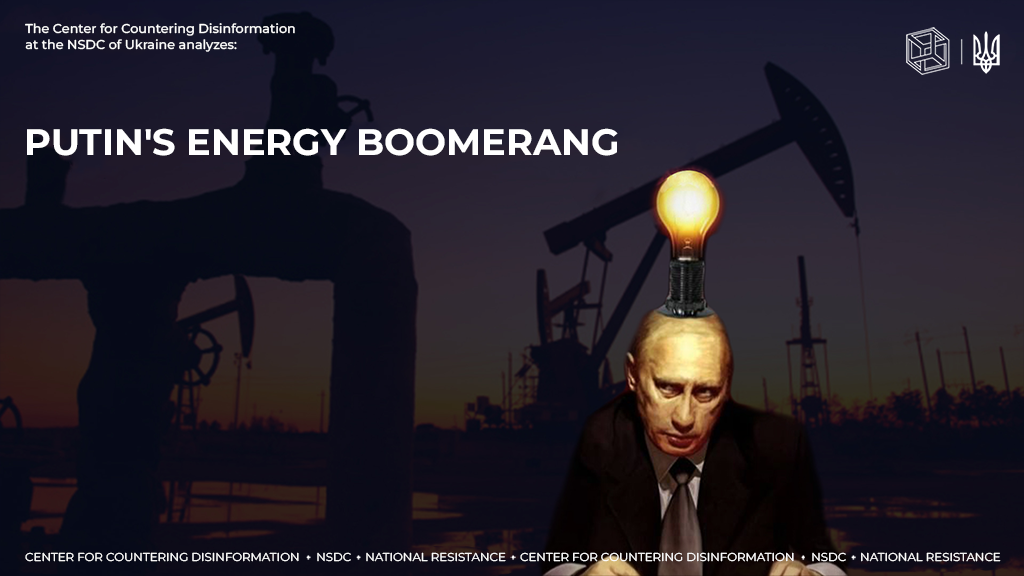The russian aggression against Ukraine and the kremlin’s energy war with Europe have become the most serious test for the global energy market and a turning point in relations between the European Union and russia in the last half century.
Putin hoped that the EU’s strong dependence on imports of russian energy resources, in particular gas, would allow him to split the EU, removing his desire to actively support Ukraine. Did the European Union succumb to energy blackmail and how did it affect the kremlin?
🔸 Gas.
Throughout 2022, russia gradually reduced the volume of supplies of blue fuel to the EU (since March 2022, the daily volume of gas pumping to the EU has decreased by 80%). In January 2023, Gazprom reduced the pumping of blue fuel into the European Union by another 22%. The obvious purpose of these actions was to try to destabilize the EU energy system and provoke a jump in gas prices, which would make it unprofitable to support Ukraine.
However, the EU withstood russia’s blow in the gas battle, which was facilitated by abnormally warm weather and concerted actions by European leaders to reduce russia’s gas dependence. In particular, the countries agreed to fill gas storage facilities by at least 80% (more than 90 billion cubic meters) at the expense of supplies from Norway, the USA, and Algeria. Of course, the hyped purchases of gas on the world market took place at prices 5-7 times higher than in 2021. However, this did not come as a shock to domestic consumers, because EU countries compensated for high prices from state budgets (since September 2021, subsidizing prices for gas, electricity and gasoline cost the EU 600 billion euros). In order to preserve the electricity market in the conditions of expensive gas, countries decommissioned coal-fired power plants, extended the service life of nuclear power units and additionally invested in renewable sources. There was also a forced restriction of gas consumption, many countries had to stop energy-intensive enterprises for the production of metals and fertilizers. In Germany, so-called price brakes were installed, forcing households and small and medium-sized businesses to cut gas and electricity consumption by 20% compared to 2021. Against the background of these events, gas prices in the EU decreased to the level of August 2021 – to 700 dollars per thousand cubic meters.
For the kremlin, European gas blackmail led to the loss of a monopoly on the European market, because before that every third cubic meter of gas in Europe was russian (155 billion cubic meters of gas per year). According to forecasts of the International Energy Agency (IEA), russia’s share of the world gas market will fall from 30% in 2021 to 15% in 2030 (in the base scenario) and to 10% (in the optimistic scenario). At the same time, the Russian gas export revenue will drop from $75 billion to less than $30 billion.
A huge network of gas fields and pipelines, on the development of which hundreds of billions of dollars were spent, is actually thrown into the trash. In particular, investments in the development of gas fields on the Yamal Peninsula ($100 billion), most of which were connected by pipelines to Europe, including Germany, became useless.
The attempt to find new gas sales markets in the East faces the problem of financing. Thus, the cost of modernization of the “Power of Siberia” gas pipeline to China is estimated at 55 billion dollars, which is simply not available against the background of the war in Ukraine. In addition, the kremlin’s hopes for an increase in gas demand in China are not coming true.
🔸 Petroleum products.
The kremlin failed to shake the European oil market. After a significant increase in the first half of 2022, the European oil price is currently back to the level of last January.
For the kremlin, blackmail turned into the loss of the European market, which consumed almost 2.5 million barrels of oil daily and 1 million barrels of petroleum products annually. The EU ban on the sea import of russian oil left Bulgaria as the only market, which received a temporary exception. Outside the EU, the supply of russian petroleum products to Saudi Arabia, Iraq, the United Arab Emirates and Kuwait has significantly decreased. Russia is trying to find alternative markets for its oil, mostly in India. However, the reorientation of sales of petroleum products has a huge price for the oil industry of the russian federation, because in order to penetrate the Indian market, large discounts were needed, reaching 35 dollars per barrel, which is equivalent to a 40% price reduction.
❗️ Summing up, it can be argued that the energy war against the EU returned to the russian federation with a boomerang. The attempt to persuade Europe to make concessions on the “Ukrainian issue” permanently deprived the russian federation of its status as a leading energy state. As a result, according to IEA forecasts, russian energy exports will never return to the level of 2021, and by 2030 will fall by 50%. As a result, russia will lose about 1 trillion dollars of revenues from the export of energy resources by 2030. Even after the end of the war, it is unlikely that EU countries will ever return to putin’s energy hook.










